
The Ultimate Olive Oil & Vinegar Pairing Guide for Salad Dressings
Share
The secret to a great salad isn’t just the greens, it’s in the dressing. Whether you're a fan of bold arugula, buttery spinach, or classic romaine, the right combination of olive oil and vinegar can take your salad from basic to unforgettable. Welcome to the ultimate olive oil vinegar pairing guide, created for food lovers, home chefs, and anyone ready to master the art of vinaigrettes.
With so many flavor profiles available, ranging from sweet balsamics to spicy olive oils, finding the perfect dressing balance can feel overwhelming. This guide simplifies the process, offering practical tips, a pairing chart, and recommended products so you can craft your ideal salad every time.
To begin your journey with high-quality oils and vinegars, start with this curated collection of premium vinegars for every kitchen: Explore artisan vinegar selections.
Why Pairing Matters: The Foundation of Flavor
A well-balanced vinaigrette typically contains three components:
- Fat – usually extra virgin olive oil
- Acid – usually vinegar (balsamic, wine vinegar, or fruit infused)
- Flavor Enhancers – herbs, spices, mustard, or sweeteners
Getting the oil and vinegar ratio right is only part of the equation. Understanding which olive oil and vinegar flavor combinations work together helps create depth, enhance the base ingredients of your salad, and introduce unexpected bursts of flavor.
For example:
- A peppery olive oil pairs beautifully with a sweet raspberry vinegar
- A buttery olive oil works well with a bright citrus vinegar
- A robust Tuscan oil complements aged traditional balsamic
The possibilities are endless, but with the right guide, your pairings become intuitive.
Essential Olive Oils to Know
To begin, let’s break down some popular olive oil varieties and their flavor profiles. Choosing the best olive oil for vinaigrette starts with knowing what each oil brings to the table.
|
Olive Oil Type |
Flavor Profile |
Best Pairings |
|
Arbequina |
Mild, buttery, fruity |
Citrus, fig, or pear balsamic |
|
Koroneiki |
Robust, peppery, grassy |
Pomegranate, traditional balsamic |
|
Picual |
Herbaceous, green tomato |
Sherry vinegar, red wine vinegar |
|
Hojiblanca |
Delicate, floral, nutty |
Apple or white balsamic |
|
Infused Olive Oils |
Garlic, basil, lemon, etc. |
Complementary fruity or herbal vinegars |
To explore rare and gourmet oils ideal for vinaigrettes, browse this handpicked lineup of specialty olive oils for pairing and finishing: Discover infused and specialty oils.
Choosing the Right Vinegar: Flavor Depth & Acidity
Just as olive oils vary in strength and complexity, vinegars range from sharp and tangy to sweet and syrupy. In the world of salad dressings, a touch of fruit, herb, or aged acidity can make all the difference.
|
Vinegar Type |
Flavor Profile |
Best Uses |
|
Traditional Balsamic |
Sweet, aged, rich |
Tomato-based salads, Caprese, roasted veg |
|
White Balsamic |
Lighter, fruity, slightly sweet |
Summer greens, stone fruit, seafood |
|
Apple Cider Vinegar |
Tart, bright, fruity |
Slaws, kale salads, warm grain bowls |
|
Red Wine Vinegar |
Sharp, dry, classic acidity |
Greek salads, Mediterranean dishes |
|
Fruit Infused Balsamics |
Raspberry, pear, peach, pomegranate |
Delicate greens, dessert salads, vinaigrettes |
When you understand the acidity level and sweetness of your vinegar, you'll be better equipped to achieve the perfect dressing balance.
Classic Salad Dressing Combinations
To help simplify things, here’s a practical pairing chart with common flavor combinations that work beautifully in vinaigrettes:
|
Olive Oil |
Vinegar |
Suggested Additions |
|
Arbequina (buttery) |
Raspberry Balsamic |
Toasted almonds, feta, spinach |
|
Lemon Infused Olive Oil |
White Balsamic |
Mint, strawberries, baby greens |
|
Tuscan Herb Olive Oil |
Traditional Balsamic |
Tomatoes, mozzarella, fresh basil |
|
Garlic Infused Olive Oil |
Pomegranate Balsamic |
Arugula, walnuts, shaved Parmesan |
|
Picual (green and bold) |
Apple Cider Vinegar |
Chopped kale, quinoa, dried cranberries |
Use a 3:1 oil to vinegar ratio as a starting point and adjust according to taste. For sweeter vinegars like balsamic, a 2:1 ratio may be better. And remember, always whisk or shake vigorously to emulsify.
Balsamic with Olive Oil Recipe: A Simple Vinaigrette
Here’s a go to vinaigrette recipe using the classic pairing of traditional balsamic and robust olive oil. It's perfect for everyday salads and can be made in under five minutes.
Basic Balsamic Vinaigrette
- 3 tablespoons extra virgin olive oil
- 1 tablespoon traditional balsamic vinegar
- 1 teaspoon Dijon mustard
- 1/2 teaspoon honey or maple syrup
- Salt and pepper to taste
Whisk until smooth or shake in a sealed jar. This dressing complements tomato salads, roasted vegetables, or even grilled meats.
Want to level up your salad-making game? Consider serving and mixing your dressings in high-quality, stylish pieces like pourers and bowls from this curated line of artisan olive wood salad tools: Shop handcrafted olive wood products.
Tips for Building Better Salads with Balanced Dressings
Knowing how to pair your ingredients is only half the battle. Here are some key tips for building salads that fully showcase your olive oil and vinegar pairing:
- Balance textures – Combine crunchy (nuts, seeds), creamy (cheese, avocado), and crisp (greens, cucumber) elements.
- Consider seasonality– Use fresh summer fruits or hearty fall grains to match your flavor base.
- Layer & flavors – Mix sweet, salty, sour, and umami for complexity.
- Dress gently – Always toss your greens lightly with dressing to avoid sogginess.
By building salads with complementary textures and flavors, your dressing will have the chance to shine instead of overpowering or disappearing into the background.
DIY Vinaigrette Ratio Chart
|
Oil Type |
Vinegar Type |
Flavor Notes |
|
Basil Olive Oil |
White Peach Balsamic |
Floral, summery, light |
|
Garlic Olive Oil |
Honey Ginger White Balsamic |
Spicy sweet, great for Asian salads |
|
Lemon Olive Oil |
Pomegranate Balsamic |
Bright and tangy, ideal for winter mix |
|
Classic EVOO |
Red Wine Vinegar |
Bold, acidic, best for hearty greens |
Final Thoughts
Creating the perfect salad dressing starts with choosing the right ingredients, and that begins with understanding how olive oil and vinegar work together. From bold and complex to light and fruity, your flavor combinations should complement your ingredients and reflect your taste.
By using this olive oil vinegar pairing guide, you’ll have the confidence to mix, match, and customize your own signature dressings for every season. Whether you're prepping a quick weeknight salad or entertaining guests, a thoughtfully crafted vinaigrette brings your dish to life.
Explore your creativity, taste widely, and stock your pantry with high-quality oils and vinegars that make every meal an occasion.
